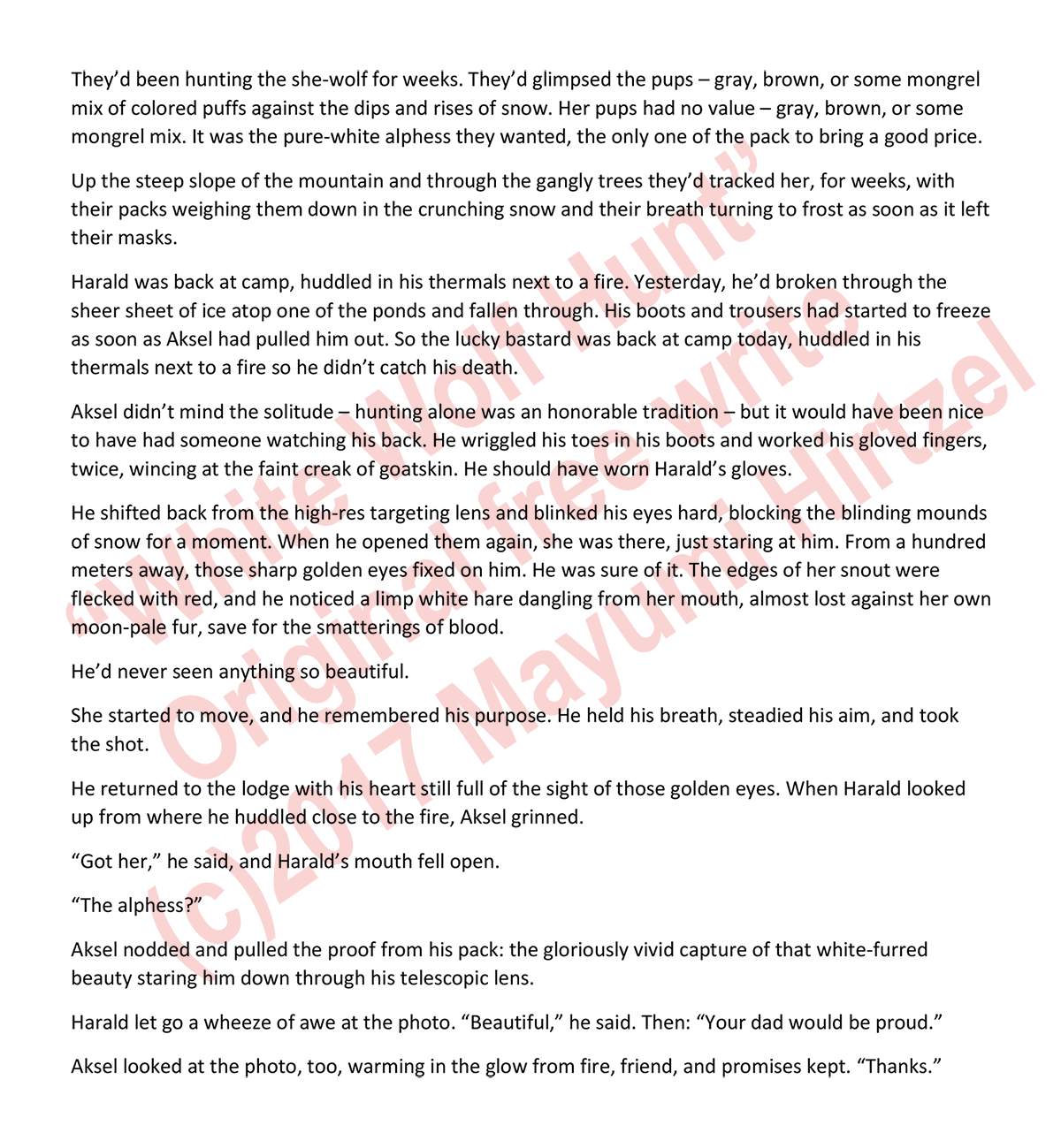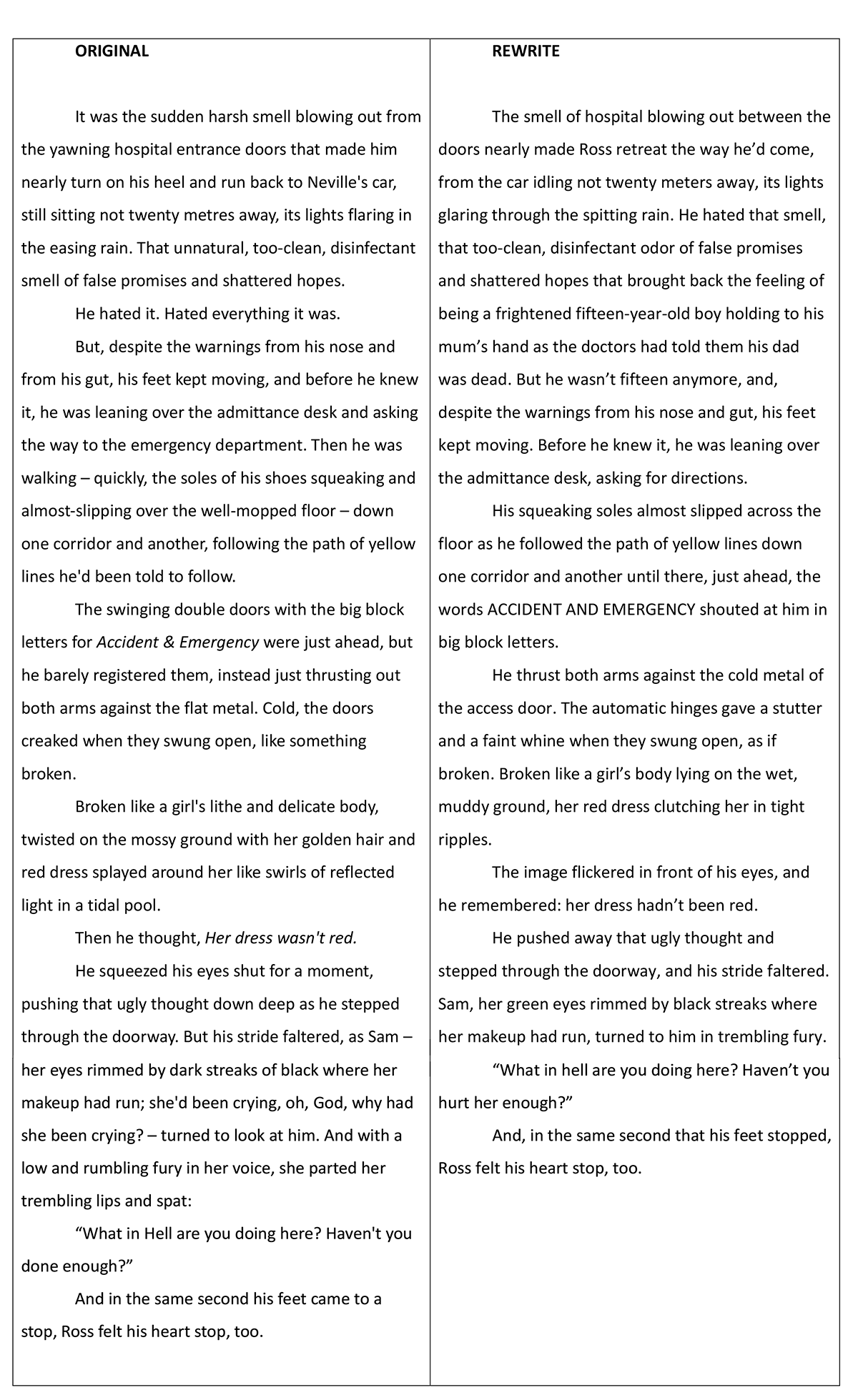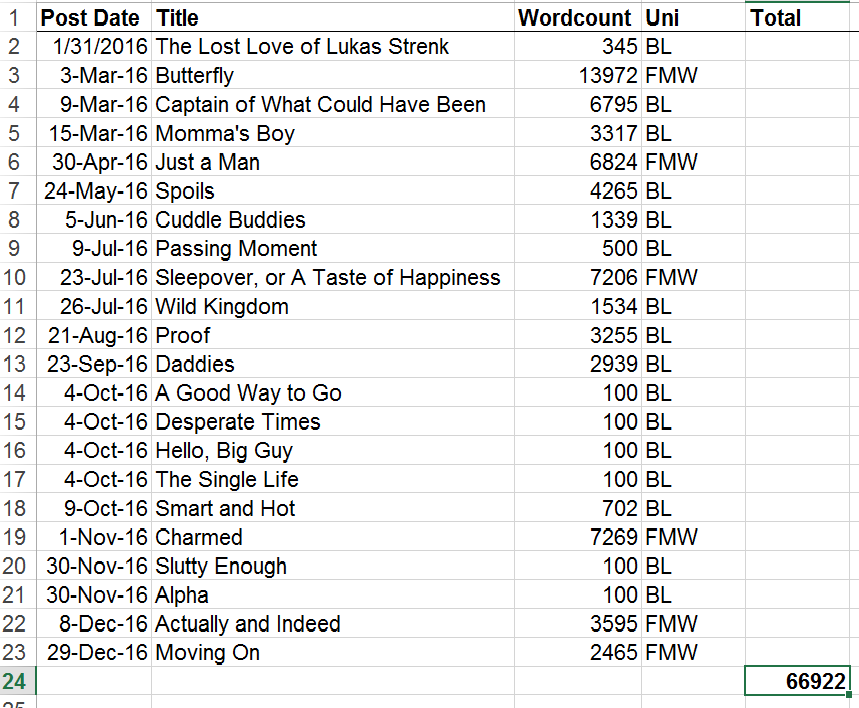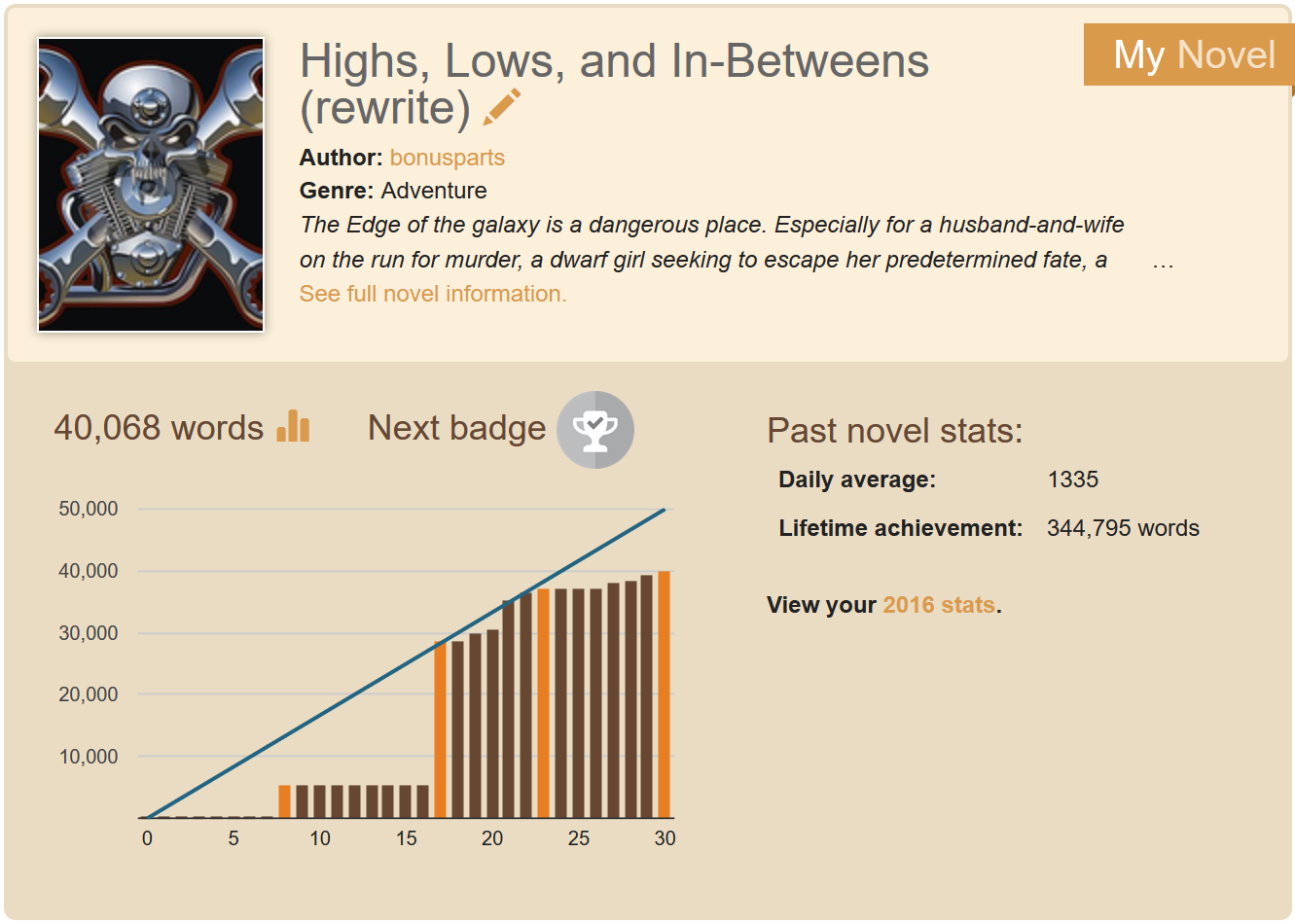by Mayumi-H | Apr 11, 2017 | Process, Short Stories
I’m one of the winners of 4amWriter’s “Save El Lobo Writing Competition”!
Head on over to Kate’s page and read her update, which includes all the winning entries. And, if you should be inspired to write your own wolf story, let me know. I’ll howl for you!
For those of you who are interested in how I approached this particular challenge, read on….
Whenever I set my mind to a writing challenge, the first thing I consider is what I can bring to it: style, scenarios, conflicts, maybe a plot twist for the ending. For Kate’s challenge – to write a short story or poem featuring wolves in a positive light – I knew I wanted to use description, to depict the beauty of a wolf in nature. After a few minutes of staring at the ceiling, letting my brain percolate, I came up with the not-very-subtle twist of a photographer using a sight and taking a “shot” much like a sniper might. The hunt of a photographer waiting for the perfect shot is much like waiting for the perfect moment when a target comes into the crosshairs. It would also allow me to tell a story in mostly-silent descriptive and action passages, a technique that’s been prevalent in my pleasure reading, of late.
Once I’ve got my scenario, I figure out who’s going to play my primary character. Given the plot I’d come up with, my PC needed to be a human. I’ve got a stable of go-to characters, but I wanted to do something a little bit different, this time. The main protagonist, Aksel, is a combination of bounty hunter Axton with a little bit of domestic dad Rob McAllister thrown in. Neither of those men can go anywhere without their respective partners, so I dropped in Aksel’s buddy Harald as something of a counterpoint to Aksel’s skill, and to give him someone to reveal his success to in the end.
Next, I just…start writing. Some images and descriptions flow fine, while other parts are obviously less polished. I even double-up on some phrases when I free-write, to play with the order of words and see how they fit. The picture below (click on it for the full-resolution version) shows my original draft in all its messy, stream-of-consciousness rawness. 
As should be fairly clear, I don’t edit when I free-write; I just keep typing until I complete the idea. This free-write went on too long – almost 200 extra words too long – and it needed plenty of reworking. That doesn’t mean something good didn’t come out of it along the way, though.
This challenge’s tight word count confines – we were allowed 250 words max to tell the story – meant that I had to choose carefully what was worthwhile to the story as a whole. A lot of the setup and extraneous action had to go. For example, Aksel’s buddy Harald’s dump in the ice pond, as well as a slightly deeper explanation of the men’s relationship, neither of which did much for the main plot. I also really liked the idea of the protagonist facing down the white wolf alone.
The last bit – the reveal of the purpose of the photo quest – came about completely by accident, when I was typing out the men’s dialogue. I hadn’t even considered the relationship between Aksel and his father until those words came out from Harald’s mouth! I liked it a lot, though, even if it meant going back and figuring out a new lead-in for the story.
All in all, I like the final submitted version. It changed along the way, as stories tend to do. It even changed titles, from “White Wolf Hunt” to “Eyes of Gold Fire”. Since I’d already decided in my head that Aksel’s father had died, I could have had the primary character spend the entire story alone. But, I liked him having someone with whom he could share that tiny triumphant moment of the photo reveal. Because stories are better when they’re shared. Just like this one.
What’s your process for writing challenges? Have you submitted your writing to any contests lately? What did you think of my story of Aksel and the white wolf?
by Mayumi-H | Mar 2, 2017 | Fearless, Finding Mister Wright, Process
It’s been a rough start to the new year. Work has been busy, yes, and social media has become a larger part of my job. Between that and homework home life, some things just need to get pushed to the side.
When life gets me down, I enjoy revisiting the stories that brought me joy, either in the creation, the characters, the story, or sometimes even just the memories of the process. Back in 2011, my NaNoWriMo project was a romance story called Fearless. I loved those characters so much, I returned to them in a 10-years-later glimpse in one of my “Finding Mister Wright” short stories (the story is no longer available online, but you can read about my reasons for writing it at the link). That’s not what this post is about, though.
Whenever I go back to older writing, I always get the urge to re-do it. In the case of Fearless, the story is already undergoing a major overhaul, but the guts of it are still there. The original scene below was one of the first things I wrote for this story, and it was conceived as a teaser opener, so online readers would know up-front what they were getting into. When I opened this up again the other day, I still liked it…but I knew it could use some work. The “rewrite” version below is not a final version, but I think it does do the job a bit better than the “original”. You’re welcome to read the comparison or skip over it; it’s there mostly as a personal prod that this is a work-in-progress that should get some of my attention.
Most of my free reading time is devoted to pleasure books – on my bedside table right now are a Mankell Wallander crime book, Sapkowski’s second collection of The Witcher short stories, Glukhovsky’s Metro 2033, and a few others – but reading those stories of which I once felt proud for finishing gives me pleasure, too. Of course, it would be nice if someday some other person can enjoy a story I’ve written, but the journey is one of progress. I’ve said before that writing “The End” when we finish a story isn’t really The End. There’s a long road of re-reads, rewrites, and re-evaluations to be done. But it’s also fun just to play, and to wonder what could be.
So, I’m not dead…though, there are days when it feels like I’m not much more than that. As for you, dear friends, read well, write strong, and be excellent to each other out there. Your stories are worth telling.
by Mayumi-H | Jan 2, 2017 | Persona 4 Fan Fiction, Process
Whenever I feel like I haven’t produced anything in a while, I look at what stories I’ve posted. 2016 might not have been my most prolific year, but I did write – and post – a little bit over 66,000 words, across 22 stories. I’m not including the work I did on the rewrite of my sci-fi adventure story, or all of the back story snippets I hashed out when the editing wasn’t working to my liking, or the starts to stories I scrapped or set aside because I went back to editing and rewrites, because those have not been seen by eyes other than mine. They would also be a lot harder to calculate.
Not a great year for output, but not as poor as I’d originally suspected when thinking back on it.

Not every one of these stories is great, but each one represents a personal effort, and my desire to become a better storyteller. If I had to pick a favorite, I know which one I’d choose…but I won’t say because a parent playing favorites is not a good thing. 😉
For those of you who took time out of your lives to read any of these, and especially to those folks who let me know what they thought, thank you from the depths of my artist’s heart. Hearing that I’ve touched, amused, or entertained someone else with these stories keeps me going day after day.
What was your 2016 year in writing like? Any surprises, challenges, or turnarounds? Here’s looking forward to a strong 2017 in all of our writing goals!
by Mayumi-H | Dec 1, 2016 | From Hell (A Love Story), Process
Well, I didn’t hit the 50K word count goal for NaNoWriMo 2016, but I wasn’t planning on doing that. (I’m trying to remind myself that I didn’t really “fail” this year’s NaNoWriMo challenge, because my goals were different from the word count ones. It’s kind of working.) Instead, I focused my energies on the rewrite of Highs, Lows, and In-Betweens, the sequel to my space opera/western romance novel, From Hell (A Love Story). I still got a little over 40K done, though, so that’s pretty good!

One of the unique joys-slash-conflicts I always experience during an edit or rewrite is the comparison between what happened in the first draft, when the words are just gushing out, to the more thoughtful edit, where I try to pick apart, rework, and sometimes even build anew the character motivations, relationships, conflicts, and plot events. During my NaNo rebellion over the past thirty days, I took the bones of my five protagonists (I know; that’s a lot of protags, but that’s a discussion for another day) and really rebuilt them. They’ve become a lot more complicated, and a lot more engaging because of that. At least, I think they are.
The first draft of the story, which I wrote in 2014, was a lot of fun, and many of the main story points are still there. But now, after tearing parts of it up and delving deep into who these people truly are at their cores, there is a new villain, a new love story, a new betrayal, and a whole new possibility for this adventure to go far beyond the simple introductory tale it was at the beginning.
I will keep working on this rewrite, because these characters are too interesting to let fall to the wayside. I’m sure I’ll also be writing new stories, too, because I just can’t keep myself from examining what the other characters in my other worlds have been doing. In short, I’ll just keep writing, NaNo or no NaNo.
Did you participate in NaNoWriMo this year? How did you do? What projects are you working on that you’re excited about?
by Mayumi-H | Jan 16, 2016 | From Hell (A Love Story), Persona 4 Fan Fiction, Process
Since the first flash of a projectile from a barrel around 1000 CE, the gun has had a rich and varied history across most all avenues of life: social, economical, political, and creative. It also has the power to divide people and opinions like no other tool before or since. Let’s be clear: a gun is a tool. It is specifically designed to make easier the task of killing, of human or other animal. Now, one can certainly use a gun to accomplish goals besides killing – say, destruction of a barn wall, for those not well-versed in the skill of shooting a target – but their primary function is to kill, with more power, speed, and accuracy than any other weapon (assuming said gun is in the hands of an expert).
Politics aside, I have always found guns fascinating, especially their varied designs, and how beautiful they can be. Take a look at the craftsmanship in the Colt below:

I didn’t grow up around guns, but I had my share of toys for games of ranchers and rustlers with the boys next door, and I talked about them a lot with my father, who’d been an Army sergeant in Vietnam and who’d had an intense respect for firearms and war weaponry in general throughout history. He’d impressed upon me at a young age that guns are dangerous, doubly so if they’re not handled with respect. As I got older, we delved into the specifics of them: “I would much rather you know how to properly use a gun and never have to,” he’d say to me time and again, “than find yourself in a situation where you had to use one but didn’t know how.” He never squelched my interest in them, but he always made sure I understood the inherent danger in them, and the enormous responsibility a person has whenever they pick one up.
I’d written stories with characters who’d used guns since I was a kid: Han Solo’s DL-44 heavy blaster pistol, the Enterprise crew’s type 2 phasers, my D&D-inspired thief’s flintlock pistol. In those early forays, guns were simply weapons of convenience that often made a cool noise or shot a bright laser beam, and I didn’t think much about their impact (pun not intended). It wasn’t until a few years ago, when I wrote the gunsmith in From Hell (A Love Story), that I really thought about what I was saying about guns through my stories when my characters squeezed a trigger. There’s a semi-pivotal moment in the story where this gunsmith and the main character argue about throwing blind cover fire into a crowd of civilians. The gunsmith’s argument is that they’re surrounded by people, while the main character points out, “Yeah, and at least one of them is shooting at us.” The ramifications of their choices follow them through the rest of the book, but it was important to me that both of them realize: odds are good that when you pull out your gun, people will die.
Because I’d grown up being taught to respect – not fear – guns, I wanted that respect to come through in this story. Even in the books and stories I was reading to get a feel for a dirtier galaxy based on the Old West, the characters treated their guns like the closest partners they’d ever have, which was probably pretty close to the case in those wilder frontier times.

Stories are not soapboxes, though, and it can be difficult for a writer to separate their personal views from those presented within their prose. Firefights offer great opportunity for excitement, high action, and conflict. But a quick-trigger topic like gun use (ha ha) requires at least some responsibility on the writer’s part. Like any weapon, they’re dangerous, and our stories would lose a measure of realism without addressing just how dangerous they can be. We can do this through the actions, reactions, thoughts, and dialogue of our characters, as well as offering realistic depictions of what happens when those characters use their firearms without awareness, caution, or respect.
Have you ever written a gunslinger? What do you think about guns – or any weapons – in stories? While realism is important, how much do you think a story requires to be seen as effective in its telling?
by Mayumi-H | Nov 7, 2015 | Persona 4 Fan Fiction, Process
Sometimes, separating the writer from the character is hard. We find ourselves putting our own traits into those of our protagonist, so they become mirrors of us. They may share the same taste in music, food, or hobbies. Their favorite sports team may be ours; that song on the radio we just can’t stand may make them grind their teeth, too.
One trait that I’ve noticed that comes through in all of my favorite characters is an interest in cooking. Their proficiency levels vary (from Chie’s ignorance about what “simmer” means, to Marshall knowing the recipe for drop scones so well he can make them in his brother’s kitchen without a book), but they always enjoy cooking. It may have different meanings for them – a desire to please, a need to control, sometimes just a way for characters to relax or get to know each other better – but even those meanings are from my own experience.
Even though I’m not actively writing while I do it, cooking allows me the freedom to let my mind wander. It’s a time of day I usually spend alone with my thoughts, and those thoughts almost invariably turn to my stories and characters: Does Paige sneak chopped vegetables from the cutting board while Daniel looks away? Does Ross sway with Amber as she stirs some sauce? Does Axton have to stop making breakfast because the hounds won’t settle down?
No matter who the character is – doctor, dancer, reckless bounty hunter – they’re all me, in a way. I’m no doctor; I’m barely a dancer; I couldn’t track a skip to save my life. But there are more basic traits we share between us, like joy for art, work, and – sure – cooking. In honor of that sense of sharing, I thought I’d share a bit of a recent cooking experience: curried shrimp and mango soup. The photos below detail the real-life steps I took, but rest assured as ingredients were browning, bubbling, and coming together in that Dutch oven, my brain was equally bubbling with ideas for where my next story should go. And, of course, there’ll be cooking.
If you’re interested, here’s the recipe, originally from Eating Well:
Ingredients
- 1 tablespoon extra-virgin olive oil
- 1 large onion, chopped
- 2 stalks celery, sliced
- 4 cloves garlic, chopped
- 1 serrano chile, minced (optional)
- 2 tablespoons curry powder
- 1 teaspoon dried thyme
- 2 cups seafood broth or stock or clam juice
- 1 14-ounce can “lite” coconut milk
- 3 ripe mangoes, diced
- 1 1/4 pounds raw shrimp, peeled and deveined
- 1 bunch scallions, sliced
- 1/4 teaspoon salt
Preparation
- Heat oil in a Dutch oven over medium heat. Add onion and celery and cook, stirring occasionally, until beginning to brown, 3 to 5 minutes. Add garlic, chile (if using), curry powder and thyme; stir constantly for 30 seconds. Add broth (or stock or clam juice), coconut milk and mangoes. Bring to a simmer over medium-high heat. Reduce heat to maintain a simmer and cook, stirring occasionally, for 5 minutes.
- Puree 3 cups of the soup in a blender. (Use caution when pureeing hot liquids.) Return the puree to the pot and bring to a simmer. Add shrimp and cook until pink and firm, about 3 minutes. Stir in scallions and salt.
What personal traits – if any – do you find you share most commonly with your characters? What do you see your characters doing when you’re cooking, doing the wash, or some other regular chore? Do you think you’ll try the curried shrimp and mango soup recipe? Let me know in the comments!







Recent Comments
The Real Person!
Author Mayumi-H acts as a real person and passed all tests against spambots. Anti-Spam by CleanTalk.
The Real Person!
Author Mayumi-H acts as a real person and passed all tests against spambots. Anti-Spam by CleanTalk.